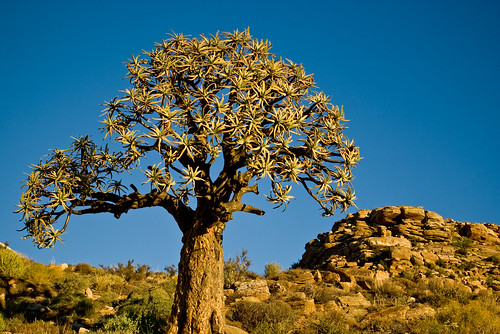Quiver Tree – Root and Branch Review
Key Features of the Quiver Tree
- Latin name Aloe Doichotoma other common names Kokerboom
- Height up to 30 feet
- Type of tree – monocotyledon
- Leaves – sharp toothed, narrow pioned blue-green leaves formed in rosettes
- Flowers – tiny, bright yellow, nectar filled flowers on 12″ spikes
- Fruit – smooth, shiny capsules flowers are edible
- Bark – Sharp edged brown scales
- Family – Aloaceae
Origins and Distribution of the Quiver Tree
- South West Africa and Namibia.
- Grows in arid areas of southern Africa.
Uses and Commercial Attributes of the Quiver Tree
- The hollowed out branches were used by the San tribe as quivers.
- The sharp-edged trunk and leaves make it a favoured tree for weaver birds to nest because it protects from snakes and jackals.
Gardeners Tips for the Quiver Tree
- Dichotoma means forked .
- The slow growing Quiver Tree with its thick trunk and rounded crown is a distinctive sight.
- A position in a hot and dry South African rock garden is best if you want to grow this aloe in a garden.
- Like other Aloe the quiver tree is easy to grow from seed given the right conditions.
Other types of Quiver Tree Species
- Aloe pillansii, the giant quiver tree, is becoming endangered by over zealous collecting .
- Aloe ramosissima, the maiden quiver tree is only found near the Orange river.
Quiver Tree comments from elsewhere
- The young flower buds can be eaten and have a similar appearance and taste to asparagus. Sugar birds are drawn to these flowers in winter where they feed on the nectar produced by the flowers. Aloe dichotoma is an extremely tough tree that may reach an age of over 80 years and a height of approximately 7 metres. more from plants Africa
- Dr Richard Pearson of the American Museum of Natural History told a conference on global warming that a species had three choices when confronted with climate change: die, adapt or migrate.For the quiver tree, any migration it made would have to come about as a result of seed dispersal via the wind or from droppings from birds or other animals that digested them. read more
Credits
Quiver Tree by hibbijibbies CC BY-ND 2.0
“Midas tree by Paul WatsonCC BY-NC-SA 2.0

